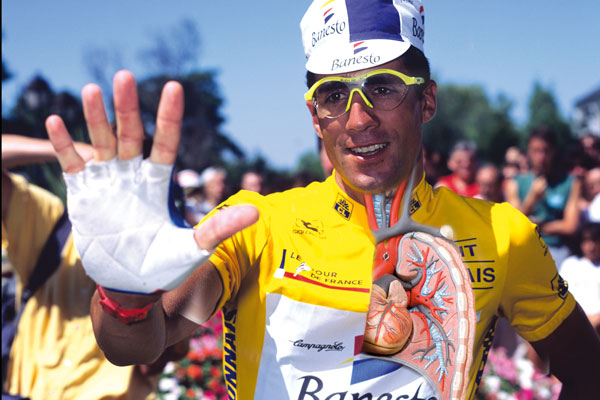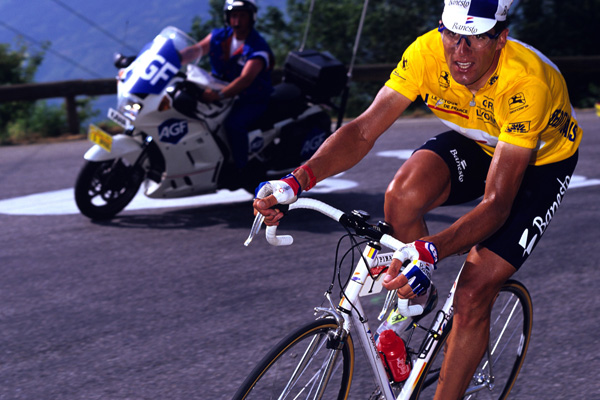Miguel Indurain vs your body

Fitness in terms of endurance activities like cycling is broadly determined by how much oxygen can be delivered to your working muscles.
This system starts with your lungs and heart and these work closely together in response to the levels of carbon dioxide (CO2) in your blood. As you begin to exercise, CO2 levels increase because CO2 is one of the waste products from burning fuel in your muscles.
When this is detected by your nervous system (which, if you use the earlier motor vehicle analogy, acts as an engine management system) your breathing deepens and quickens and your heart rate rises. Hormones released during exercise also play a role in this.
A cyclist's heartand lungs
The more oxygen your heart and lungs can deliver to your muscles, the faster you can ride. To a certain extent this is addressed by deeper, faster breathing and by increasing the heart's rate of beating.
However, there is a limit to how deeply you can breath, the number of times you can breathe per minute, and the speed and frequency with which your heart muscle can contract.
So the body's response to exercise is two-fold. Lung capacity increases, or they become more efficient, and heart chambers grow bigger and heart muscles stronger. This means more oxygen is taken in for the blood to carry, and a greater volume of blood is pumped per beat (the stroke volume).
The latest race content, interviews, features, reviews and expert buying guides, direct to your inbox!
| 72 beats per min - the average adult resting heart rate | 4.8 litres - the average male adult lung capacity | 25 litres per min - the cardiac output for a fit male cyclist |
It's worth noting at this stage that some people start out with bigger lung capacities and hearts than others, and that there is evidence that the lung and heart's response to training is genetically determined, too.
Evidence of these adaptations can be found by measuring lung capacity and resting heart rate. Heart rate in particular shows adaptation to exercise. Because a well-trained heart pumps more blood per beat, it doesn't beat as often at rest as an untrained one. A low resting heart rate is evidence of this is.
Tune up
Increasing your lung capacity is quite difficult. There is evidence that it depends of genetics, and it's influenced by how active you were in childhood and a number of other factors. One thing you can do to improve lung function is to get things that can hamper your breathing, like asthma, under control.
You can do a variety of simple exercises that will strengthen your diaphragm, which will help you exhale more powerfully. Swimming, so long as you remember to exhale under water, is very good for this.
Don't worry too much, though, because the lung capacities of cyclists who have similar ability can vary widely. Yes, his huge lungs did help Miguel Indurain win five Tours de France, but the Tour has also been won five times by a variety of riders with far smaller lungs as well.
A well-conditioned, large heart is much more of an indicator of fitness than lung capacity.
Endurance training, like riding long distances, and interval training, where you make intense efforts, will increase the size of your heart chambers. So long as you allow sufficient recovery time for adaptations to take place, and you make whatever exercise you do progressively harder.
Interval training also increases heart muscle size, which is necessary to pump more blood per beat because a greater volume of blood is heavier.
| 28 beats per min - Miguel Indurain's resting heart rate | 7.8 litres - Miguel Indurain's lung capacity | 50 litres Miguel Indurain's cardiac output |
If you follow the training schedules in Cycling Fitness these will bring about the desired changes in your heart and make your lungs more efficient.
Four-chamber pump
Your heart is a double circulation pump with four chambers that are powered by muscular walls and separated by valves. The atria, at the top of the heart receive blood and the ventricles below them pump it out. The right ventricle pumps blood to the lungs, where gas exchange takes place.
Oxygenated blood then returns to the left atrium, where a valve allows it into the left ventricle, which contracts, pumping the oxygenated blood around your body. De-oxygenated blood returns to the right atrium. Heartbeats are controlled by electrical signals which respond to levels of carbon dioxide in the blood.
Gas exchange
The primary function of your lungs is to transfer oxygen from the atmosphere to your bloodstream, as well as expel carbon dioxide from your bloodstream into the atmosphere.
To perform this gas exchange, air is first drawn through your mouth and nose and along a network of constantly dividing tubes that end in thousands of thin-walled sacks called alveoli. These are surrounded by ultra-thin blood capillaries, which is where the gas exchange takes place.
Bellows
You lungs work like bellows sucking in and blowing out air. When a thin sheet of muscle at their base called the diaphragm contracts, lung volume increases and the pressure inside them decreases compared to the outside air. This causes air to rush into the lungs, and when the diaphragm relaxes, air is pushed out again.
Your rib cage can also expand and contract, powered by muscles surrounding it. You lungs never fully empty of air, and the amount you breath in and out (the tidal volume) that's usable is nowhere near their full capacity.

This article was first published in the Spring 2011 issue of Cycling Fitness. You can also read our magazines on your computer or tablet device via Zinio, or downloading from the Apple store and also through Kindle Fire.
Founded in 1891, Cycling Weekly and its team of expert journalists brings cyclists in-depth reviews, extensive coverage of both professional and domestic racing, as well as fitness advice and 'brew a cuppa and put your feet up' features. Cycling Weekly serves its audience across a range of platforms, from good old-fashioned print to online journalism, and video.